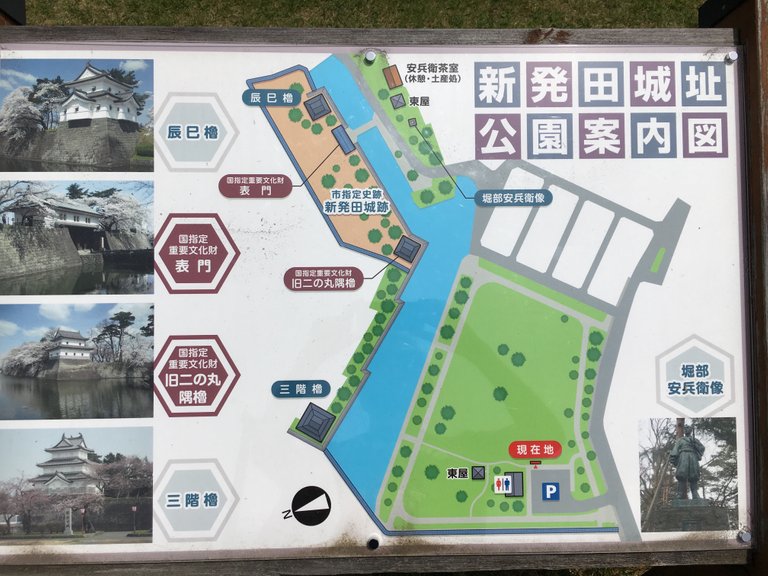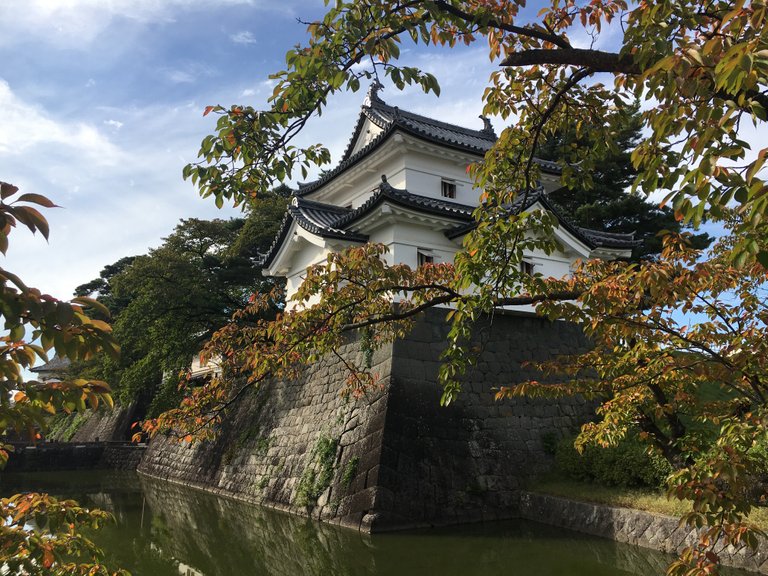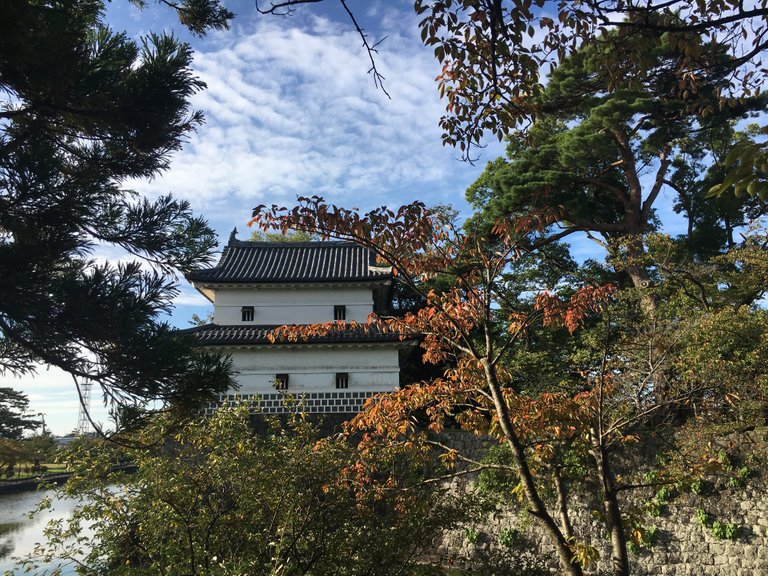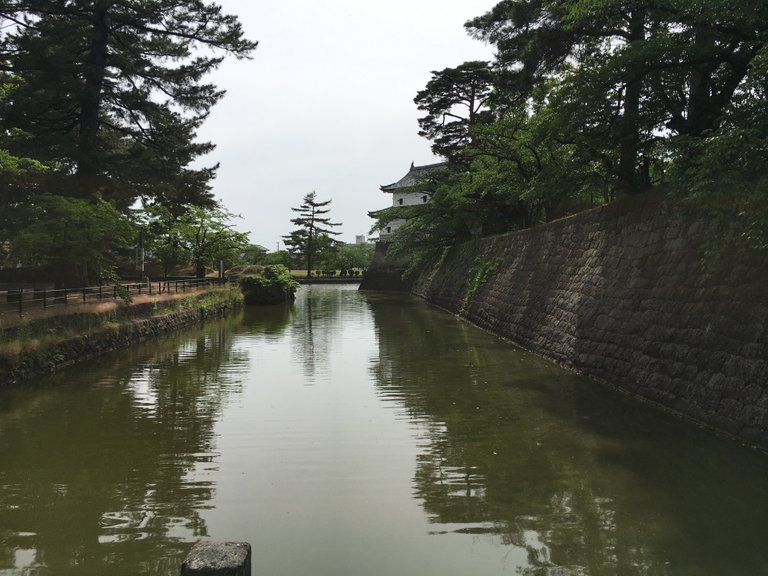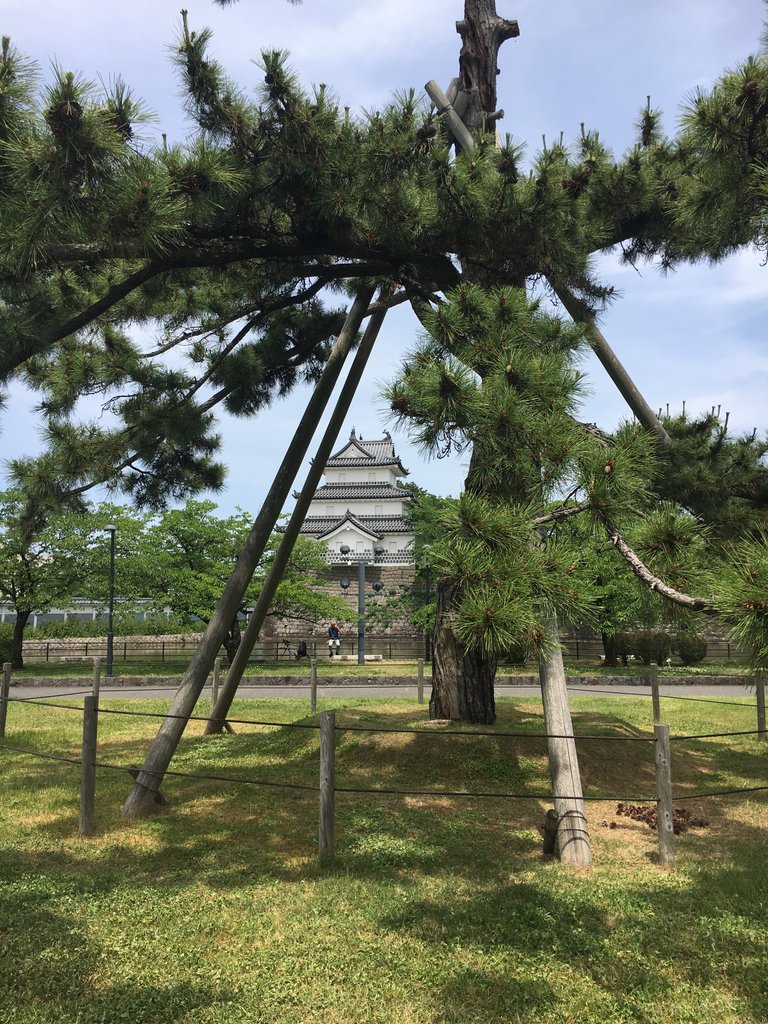Our very last trip took us to the town of Shibata, which is halfway between the Japanese sea and the coastal mountain range. During the Edo period it was the administrative center of the surrounding area and location of one of the Japanese feudal lord's (Daimyo) family. Therefor as every proper Daimyo needs to show of his wealth and power the newly assigned Mizoguchi clan also started to build up a representative castle to demonstrate their position.
Shibata-jo 新発田城 was a typical flatland castle but due to a lack of resources the reconstruction took several generations and following a strict order of the ruling Tokugawa Shogun lacked the inner castle tower. The Shogun could never be completely sure of his Daimyo's loyality and therefor avoided permitting them to build their own impregnable fortification.
After the Meiji restoration the Mizoguchi clan surrendered the castle to the new imperial government and most parts of Shibata-jo were abolished and then occupied by the new Japanese army which is still stationed here today. Of the original structure only the main gate (omotomon) and and one turret survived the change of the times but very recentlt two more turrets were reconstructed from old photographs and drawings. Shibata-jo does not bear comparison with more famous and popular Japanese castles like Osaka-jo or Himei-ji but still made it into the list of the "100 Fine Castles of Japan ". And it is still worth a visit if your are in the area and would like to get a feeling of Japanese history.
Therfore we came here already for the second time this year and I have to confess I do like this place. Not crowded at all and the visit of the remaining turrets and the Omotemon-gate is even free of charge, Shibata-jo makes for a nice day trip which can be accompanied by a nice family picnic in the adjoining park. And if the weather is fine, as it was this time, the whole scenery and atmosphere is just as Japanese as it can get.
The leaves started changing their color and added a nice touch to the whole setting and I was able to really rewind and relax for a while. Those are the moments when I appreciated being here in the Japan the most, knowing I made the ride choice for the time being.
So please have a look with me at some of the pictures I took of Shibata -jo and hopefully you will get a feeling why I do like this place.
DEUTSCH
Unser allerletzter Ausflug führte uns in die Stadt Shibata, die auf halbem Weg zwischen dem japanischen Meer und dem Küstengebirge liegt. Während der Edo-Zeit war sie das Verwaltungszentrum der umliegenden Region und Sitz eines der japanischen Feudalherrengeschlechter (Daimyo). Da natürlich jeder richtige Daimyo seinen Reichtum und seine Macht auch ordentlich unter Beweis stellen muss, begann der neu zugeordnete Mizoguchi-Klan auch mit dem Bau einer repräsentativen Burg, um hierdurch seine Stellung zu demonstrieren.
Shibata-jo 新発田城 war eine Burg im typischen Flachlandburgstil, aber aufgrund fehlender Mittel dauerte der Wiederaufbau mehrere Generationen, und augrund einer strengen Anordnung des regierenden Tokugawa-Shogun fehlte der innere Burgturm. Der Shogun konnte sich der Loyalität seiner Daimyos nie ganz sicher sein und vermied es daher, ihnen den Bau einer eigenen uneinnehmbaren Festung zu gestatten.
Nach der Meiji-Restauration übergab der Mizoguchi-Clan die Burg an die neue kaiserliche Regierung, und die meisten Teile von Shibata-jo wurden geschliffen und dann von der neuen japanischen Armee besetzt, die noch heute hier stationiert ist. Von der ursprünglichen Struktur überlebten nur das Haupttor (Omotomon) und ein Wachturm den Wandel der Zeit, aber erst kürzlich wurden zwei weitere Türme nach alten Fotos und Zeichnungen rekonstruiert und ergänzen das Ensemble. Shibata-jo hält den Vergleich mit berühmteren und beliebteren japanischen Burgen wie Osaka-jo oder Himei-ji eher nicht so gut stand, hat es aber dennoch in die Liste der "100 Fine Castles of Japan" geschafft. Und es ist immer noch einen Besuch wert, wenn ihr in der Gegend seid und ein Gefühl für japanische Geschichte bekommen möchtet.
Deshalb sind wir in diesem Jahr bereits zum zweiten Mal hierher gekommen, und ich muss gestehen, dass es mir hier gefällt. Überhaupt nicht überlaufen, und der Besuch der verbliebenen Türme und des Omotemon-Tors ist sogar kostenlos. Shibata-jo ist ein schöner Tagesausflug, der mit einem netten Familienpicknick im angrenzenden Park ergänzt werden kann. Und bei schönem Wetter, wie es diesmal der Fall war, ist die ganze Szenerie und Atmosphäre so japanisch wie nur irgend möglich.
Die Blätter fingen an, ihre Farbe zu verändern und gaben der ganzen Umgebung eine hübsche Note, und ich konnte mich wirklich eine Weile zurücklehnen und entspannen. Das sind die Momente, in denen ich es am meisten schätzte, hier in Japan zu sein, weil ich weiß, dass ich eine gute Wahl getroffen habe.
Schaut euch in Ruhe mal einige der Fotos an, die ich von Shibata -jo gemacht habe, und vielleicht bekommt ihr dann ein Gefühl dafür, warum mir dieser Ort gefällt.
This turret is one of the original structure left. Not much survived of the historical fortification during the wild years of the Boshin war which finally brought power back to the imperial family and made way for shaping the modern Japan as we know it today. Since then the days of the Samurai were over and more modern warfare took over, for Japan a very drastic change which led right into the industrial powerhouse it it today.
Dieser Turm gehört zur ursprünglichen Burganlage. Von der historischen Befestigung ist nach den wilden Jahren des Boshin-Krieges, der der kaiserlichen Familie endlich die Macht zurückbrachte und den Weg für die Gestaltung des modernen Japans, wie wir es heute kennen, frei machte, ist nicht mehr viel übrig geblieben. Seitdem sind die Zeiten der Samurai vorbei, und eine modernere Kriegsführung übernahm die Vorherrschaft, für Japan eine sehr drastische Veränderung, die direkt zu dem industriellen Machtzentrum führte, das es heute ist.
A look onto the Omotemon the main gate which also survived until today and is now the only entrance into the remaining castle grounds. The remaining and reconstructed building still give a feeling of Japanese the fabulous castle engineering and of the craftsmanship of the people who lived here during the Edo period. A small but splendid piece of Japanese castle culture here in the middle of the town of Shibata.
Ein Blick auf das Omotemon, das Haupttor, das ebenfalls bis heute überlebt hat und heute der einzige Eingang in den verbliebenen Burgbereich ist. Das verbliebene und rekonstruierte Gebäude vermittelt noch heute ein Gefühl von japanischer Burgentechnik und dem handwerklichen Können der Menschen, die während der Edo-Zeit hier lebten. Ein kleines, aber prächtiges Stück japanischer Burgkultur hier mitten in der Stadt Shibata.
I hope our little trip to Shibata-jo could help explaining why I like being in this country so much. Sure there are many things I can't stand but I haven't found the paradies on earth yet. No place is perfect but I still feel exicted beeing here in the land of the rising sun. I will be back soon with somemore impressions and pictures of this fascinating country, so please stay tuned into this channel.
Ich hoffe, dass unsere kleine Reise nach Shibata-jo dazu beitragen konnte, zu erklären, warum ich so gerne in diesem Land bin. Sicherlich gibt es auch hier viele Dinge, die ich nicht ausstehen kann, aber ich habe das Paradies auf Erden noch nicht gefunden.Kein Ort ist perfekt, aber ich finde es immer noch aufregend, hier im Land der aufgehenden Sonne zu sein. Ich werde bald mit weiteren Eindrücken und Bildern von diesem faszinierenden Land zurückkommen, also bleibt mir nur dran an diesem Kanal.

